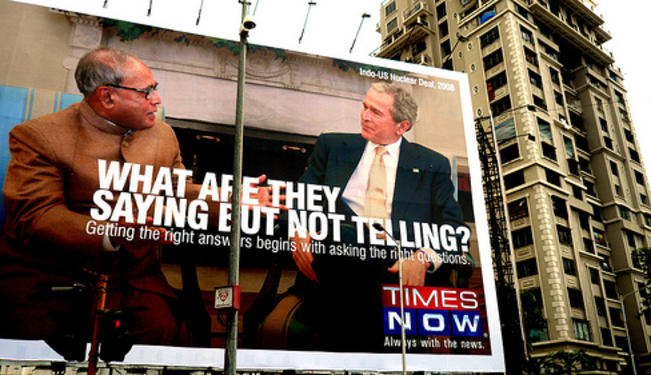A critical appraisal of India’s ability to conduct itself as a nuclear armed state.
November 2011 is a particularly appropriate time to review how effective India’s defence policy has been in managing the complex national security(NS) challenges it has been dealing with since August 1947.The short assessment is that the existing higher defence management policies are far from adequate, mired in institutional stasis though occasionally animated by individual brilliance. If indeed India has “managed” its diverse national security challenges–and also come up with some extraordinary military successes such as the Bangladesh war of 1971–it has been due to that distinctive Indian characteristic,jugaad, or innovative improvisation,and the essential resilience of the Indian jawan and citizen.
Macro-defence and security policy formulation in India is a bleak domain that has bedeviled successive governments, going back to Prime Minister Jawaharlal Nehru right up to the NDA-UPA continuum. Extrapolating from Winston Churchill’s observation of 1936, it may be averred that, apropos national security, the Indian political apex has chosen to remain, “…in strange paradox, decided only to be undecided, resolved to be irresolute, adamant for drift, solid for fluidity, all-powerful to be impotent.”
Indeed, recent events over the last year, drawn from the wide spectrum national security challenges, illustrate the tenacious Indian penchant to retain the status quo and allow the policy drift to continue. For instance, the collective Indian public memory has little recall of the 1962 war with China, and the current focus is simply on terrorism and its many tentacles.
Third Anniversary
The third anniversary of the Mumbai terrorist attack observed on November 26 points to one end of the NS spectrum against a backdrop of the Pakistani right wing party– the Jamat-ud-Dawa (JuD) spewing venom against India on the streets of Lahore. Coincidentally, just a day earlier on November 25, the Ministry of External Affairs made a cryptic announcement that the 15th Round of the India-China border talks between the two Special Representatives, scheduled for November 28, had been postponed. Deemed to be “unusual,” the last-minute postponement was attributed to scheduling problems. This may be the preferred public posture by both Asian giants–who are geographically contiguous but politically distant–but reliable sources attribute this unusual step to the Indian discomfiture over the Chinese position on the status of Jammu and Kashmir. The centrality of the Kashmir issue in the bilateral India-Pakistan relationship and the fact that Pakistan unilaterally ceded part of the disputed J&K territory to China in 1963 have only compounded an already tangled issue.
India’s national security challenges may be interrogated at three discrete levels–the upper end is the prevailing Weapons of Mass Destruction/cyber-space environment wherein India has joined a select few by declaring itself as a de-facto State with Nuclear Weapons (SNW) and a satellite capable entity; the lower end is the Mumbai syndrome–the terrorism challenge stoked assiduously by the Pakistani establishment. The middle- ground is occupied by traditional challenges including defence of territorial integrity and national sovereignty.
The challenges that have been mounted against Indian security interests are almost co-terminus with the attainment of independence in August 1947. In October of that year, a nascent free India was called upon to “defend” the State of Jammu and Kashmir, which was being threatened by Pakistani troops and a horde of tribal irregulars–a pattern that was to be repeated in Kargil in 1999. The challenge was resolutely met–the Indian military improvising with heroic professionalism–but the political handling of a pernicious challenge to the idea of India was far from astute and Mumbai of 2008 is a manifestation of a wound that festers.
Did India learn the appropriate lessons and formulate the right national security policies? The answer, alas, is the negative and consequently the 1962 war with China over contested territoriality turned into a national humiliation, a trauma from which Pandit Nehru never recovered. China is the scar that abides and notwithstanding the rapprochement that began in 1988 under Prime Minister Rajiv Gandhi, the last two decades have seen the asymmetry between the two neighbours grow in Beijing’s favour.
In the last two decades since the end of the Cold War, there has been a gradual re- appraisal of India’s holistic military security capabilities and the need to bolster this strand of national power, but the progress has been halting due to inadequate macro-policy coordination.
Thus India exercised its long-held nuclear option and acquired nuclear weapons in May 1998. Over a decade later, the texture of the Indian deterrent is uneven. Two clear examples are self-explanatory. A nuclear weapon state must acquire and exude both credibility and transparency in its command and control of this apocalyptic capability in the pursuit of deterrence and stability. Although it is understood that the designation of an alternate nuclear command authority is mandated by the 2003 Nuclear Doctrine, the Indian political apex has demurred from publicly making this known. Consequently, to the detriment of its credibility, the chain of control over the nuclear deterrent, should we come to lose the prime minister– who is in charge–in a first strike, remains unknown to Indians and adversaries alike. The Indian doctrine of No First Use (NFU) calls for very high levels of operational readiness but an anomalous situation prevails.
Chains of Control
Currently, the Indian nuclear deterrent is operationally nurtured by the Commander- in-Chief, a Strategic Force Commander, a three-star officer, and at the apex is the Chairman of the Chiefs of Staff Committee (COSC)–a rotational post held by the senior-most service Chief. However, this is a very unsatisfactory macro-policy arrangement as Admiral Arun Prakash, a former Naval Chief and Chairperson, COSC pointed out in an interview: “The Chairperson COSC happens to be a key functionary in the nuclear command chain, and his role will assume further criticality with the induction of weapon systems like the nuclear submarine INS Arihant (which will go on patrol with nuclear-tipped missiles) and the Agni-V Intercontinental Ballistic Missile.”
Yet in its wisdom, since May 1998, the Indian political apex has neither found the time nor the inclination to rectify the anomalous situation that prevails, as regards a nuclear-capable nation that is wedded to NFU. Prakash further adds: “A look at the tenures of 11 chairpersons of the COSC, who held office between 2000 and 2011, shows some startling statistics. Four of them served for less than six months–one of them for only 30 days; six served between 6 and 12 months; and only three served for over one year. No chairperson has got to serve for two years. This clearly demonstrates the low importance the Government of India accords this office. Even more incongruous, for a nuclear weapon State, is [the tendency] to allocate this onerous responsibility to a part-time incumbent on a rotational basis. ”
The poverty of effective policy review and re-formulation is even more starkly seen in the continuing Indian grapple with terrorism that has a state-sponsored, nuclear element embedded in it. For India, this malignancy began in the summer of 1990 in J&K; flared up in Mumbai in1993 and recurred episodically with the Kargil war of May 1999; followed by the terrorist attackon the Indian Parliament in December 2001and peaked in the carnage of Mumbai in November 2008.
Reactive Policies
Regrettably, the long-term policy response has been stubbornly reactive and short-lived. To its credit, the NDA government, led by Prime Minister Atal Behari Vajpayee, instituted the Subrahmanyam Commission, which rendered the most comprehensive report on the Kargil failure in particular and the larger issue of higher defence management in general in early-2000. Valuable non-acrimonious recommendations were made seekinga radical review of the existing higher defence lattice–and in an unprecedented initiative, part of this Kargil Review Committee report was placed in the public domain thanks to the perseverance of the late K. Subrahmanyam.
The NDA Government swiftly constituted a Group of Ministers to take forward the recommendations into the policy domain as strategic and industrial audits are rarely done in a constructive manner and India’s most expensive policy blunder must be the hasty closing down of the HDW submarine construction in the late 1980s line due to political considerations. Similarly, the babywent out with the bath water when M/s Bofors of Sweden were blacklisted in a knee-jerk reaction in 1986 and the Indian Army has not been able to induct a new artillery piece since.
Is the government of the day aware of the need for a policy review? Yes, but in an effete manner. The Rama Rao Committee set up by UPA-I to review the Defence Research and Development Organisation and the indigenous defence sector did a stellar job but the report remains shrouded in secrecy and has not received the attention it deserves in the public domain or the appropriate parliamentary forum.
Is there a long-term policy for military acquisitions that will contribute to the goal of reasonable indigenous production in the future? Sagacious national security management would recommend such a course of action–butwhether it happens is moot. In 2011, the much-awaited decision on the Indian fighter aircraft reached laborious closure, with two European options being short-listed. Given the burden of the Bofors HDW scandals, the political apex opted to go for what is being termed as a decision based on “technical” considerations alone. This may be a politically “safe” decision but its long-term sagacity and strategic rationale is elusive.
The institutional dissonance between the civilian spectrum, represented by the political class and the permanent bureaucracy, and the Indian military, in the absence of a confident and reasonably clear policy under-pinning is only serving to further exacerbate an inadequate national security ethos. The unseemly fracas over the date of birth and tenure of the Army Chief General V.K. Singh and the controversy generated over the AFSPA in J&K are cases in point. Were these omissions due to a policy void–or worse–deliberate policy choices?
Many of India’s capabilities, both economic and military, are more notional and perceived, than tangible and tested. At a time when India’s national security challenges are becoming more complex and contested, its policy contours remain inadequate.
As ananalyst, one would identify political pusillanimity and domain diffidence as the two areas that need immediate and objective redress. Absent this determination, the Churchill prognosis may have to be qualified: sadly, Independent India can neither govern itself equitably nor defend itself effectively.
*[This article was originally pubilshed by the magazine Defence and Security of India. ]
The views expressed in this article are the author's own and do not necessarily reflect Fair Observer’s editorial policy.
Support Fair Observer
We rely on your support for our independence, diversity and quality.
For more than 10 years, Fair Observer has been free, fair and independent. No billionaire owns us, no advertisers control us. We are a reader-supported nonprofit. Unlike many other publications, we keep our content free for readers regardless of where they live or whether they can afford to pay. We have no paywalls and no ads.
In the post-truth era of fake news, echo chambers and filter bubbles, we publish a plurality of perspectives from around the world. Anyone can publish with us, but everyone goes through a rigorous editorial process. So, you get fact-checked, well-reasoned content instead of noise.
We publish 2,500+ voices from 90+ countries. We also conduct education and training programs
on subjects ranging from digital media and journalism to writing and critical thinking. This
doesn’t come cheap. Servers, editors, trainers and web developers cost
money.
Please consider supporting us on a regular basis as a recurring donor or a
sustaining member.
Will you support FO’s journalism?
We rely on your support for our independence, diversity and quality.









Comment